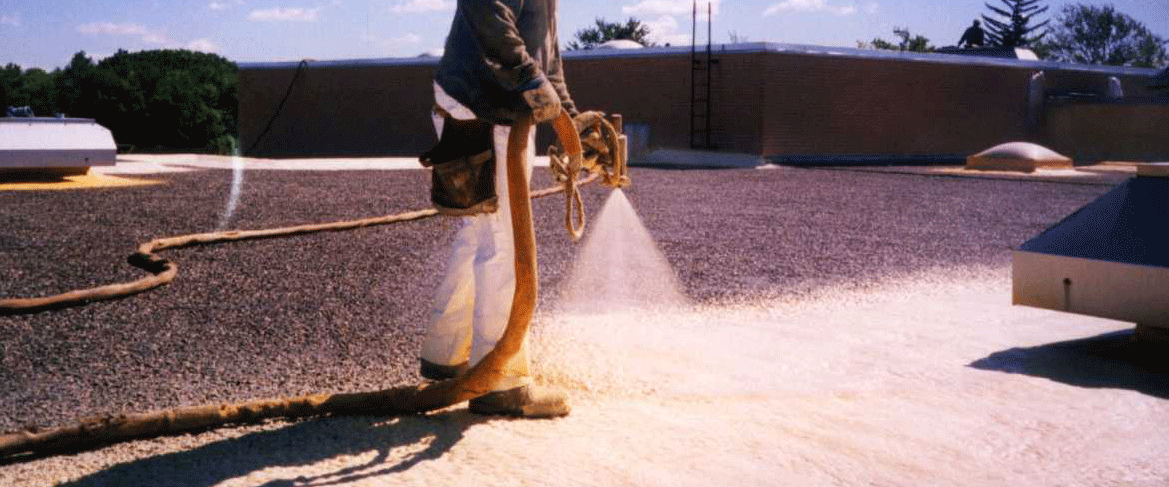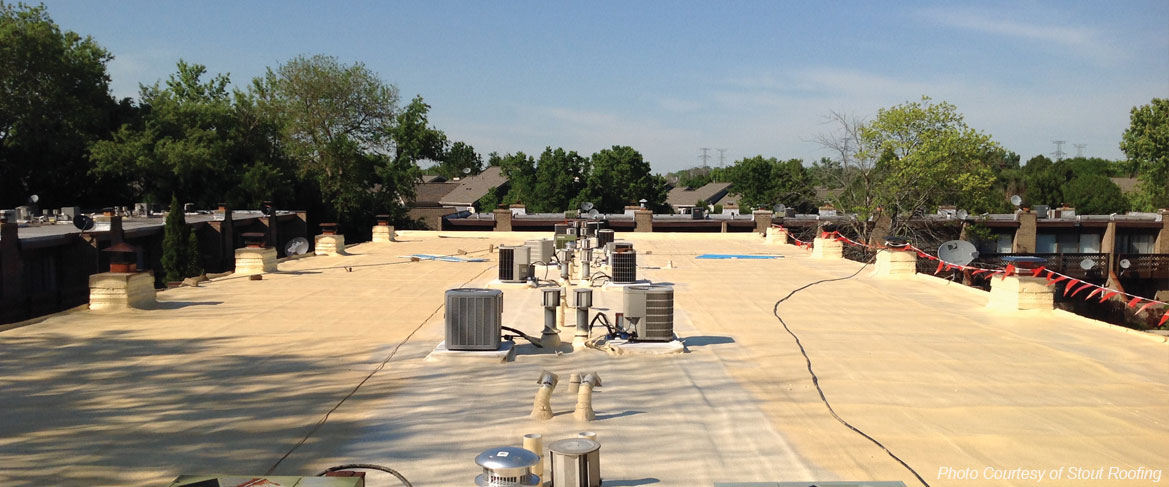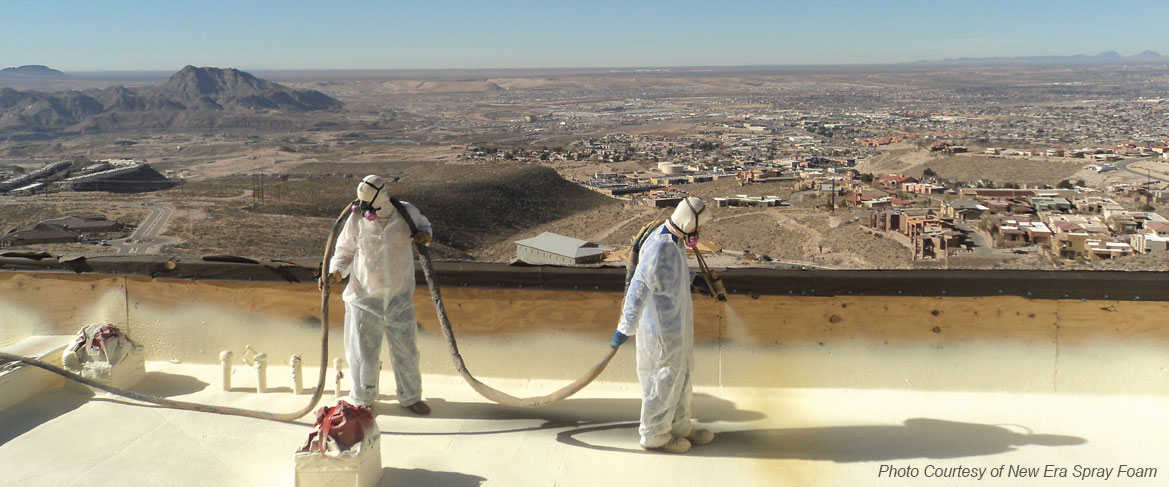Learn More About SprayFoam Roofing Benefits
Seamless & Monolithic | Adhesion & Wind Uplift | SPF is Sustainable | SPF Roof Coatings | Cool Roof Coatings | SPF Success Stories
Spray Foam Roofing Systems Provide Many Benefits to Building Owners
SPF adheres to just about everything so it can be installed over concrete, wood, steel, and most existing roof systems which saves on the expense of roof removal and landfill fees. SPF Roofing installers can spray apply a tapered roof system with the foam which eliminates the need for costly tapered insulation systems. The cants and vertical wall terminations are also spray applied making them an integral part of the roof system and minimizing additional component costs.
Turns from Liquid to Solid Monolithic Protective Roof Shell
Sprayed Polyurethane Foam is applied as a liquid using plural-component spray equipment to fill cracks and crevices. It then expands approximately 30 times its original liquid volume to form a hard, closed cell monolithic roof surface.
The Polyurethane Foam dries within seconds after applied to the roof surface. Its expansion results in a weather tight roofing membrane that is fully adhered to the substrate. Because of polyurethane's lightweight it adds little additional weight to the structure and is often used in remedial applications.
Polyurethane Foam has a history of more than 35 years as a maintainable roofing medium. Polyurethane Foam adds excellent insulation value to the structure and utility bills can reflect the difference.
Once the SPF has been applied to the proper thickness and finish specifications, a protective layer of elastomeric coating or gravel is applied. This protective layer produces a durable weather resistant surface and that can be walked on for normal maintenance.
Durability
When most people hear of a "foam" roof, they automatically think of the type of soft foam similar to that used for seat cushions and are concerned that they won't be able to walk on it without causing problems or damaging the roof. Foam roofs are very durable and can handle foot and construction traffic as well as other roofs. They are still susceptible to damage from dropped tools just as any other roof but the damage is more easily seen and can most often be repaired with some simple polyurethane caulking.
Density & R-Value
Density of SPF is important when it comes to strength and Thermal Resistance. Obviously, higher density means increased strength and higher R-value. Most SPF roofs have densities ranging from about 2.5 pounds per cubic foot to 3 pounds per cubic foot. Three pound density foam has a compressive strength of about 50 psi and an R-value of 7.14 installed and 6.86 aged (these numbers may vary slightly depending on the foam manufacturer). Here's an example of how well a good SPF roof insulates. A school district in southern California had recently installed some new, one-room relocatable classroom buildings. During the late spring and early fall, these classrooms were using their air conditioners an average of 50 minutes every hour. The school district installed foam roofs on some of these classrooms in order to see if it would provide an energy savings. The roofs consisted of three pound density foam, 1.5 inches thick with an acrylic coating system. The air conditioner usage was cut down to fifteen minutes every hour. That's a fifty-eight percent savings on energy costs.
Does this mean an SPF roof pay for itself? Absolutely! Texas A&M studies indicate that an SPF roof in Texas and other southern climates can pay for itself in approximately four and a half years.
Lifespan
If the coating for an SPF roof is properly maintained, then an SPF roof can last a very long time. Every ten or fifteen years, depending on the type and amount of coating installed, the roof will need to be cleaned, primed, and recoated. If this is done, then a quality SPF roof could last 50 years or longer.
Cost
As with all other roof systems, cost depends on several factors. Some of which include building accessibility, complexity of project, foam thickness, foam coating system, and geographical location. Costs may start at about $2.50 per square foot for a cheap system and go up from there.
Protective Coatings for Spray Foam Roofs
Once the SPF has been applied to the proper thickness and finish specifications, a protective layer of elastomeric coating, or gravel is applied. This protective layer produces a durable weather resistant surface and that can be walked on for normal maintenance.
Energy Star – Cool Roofs Program and Benefits
ENERGY STAR qualified roof coating products reduce the amount of air conditioning needed in buildings, and can reduce energy bills by up to 50%. The Cool Roof Program defines certain standards for reflectivity, and maintenance of reflectivity, in roof coating systems. These light colored roof coatings reflect the suns heat and UV rays and often lower the temperature of the roof by up to 100 degrees.
Spray Foam Roofing Installation
Installation of SPF involves different procedures based on the existing roof structure. It is important to be familiar with all state and local building codes to assure the appropriate materials and procedures meet the necessary requirements in your area.
Oklahoma Spray Foam Insulation Quote
OK Spray Foam Insulation & Roofing Services from Oklahoma's Leading Foam Contracting Solution! Call us today to discuss the best insulation options for your home, including spray foam insulation cost, benefits, r-value and more at 855-GET-FOAM (438-3626).


